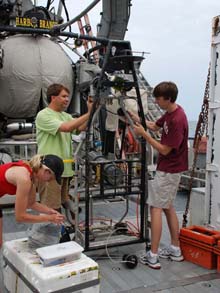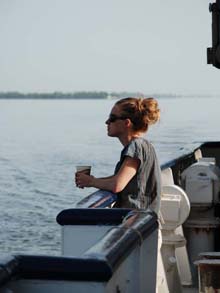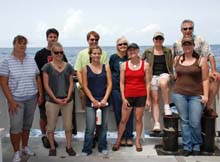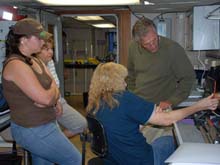
(Left to right) Dr. Erika Raymond, Dr. Sönke Johnsen, and marine biology undergrad Ryan Keith, prepare the Eye-in-the-Sea camera system for the first dive of the expedition. Click image for larger view and image credit.
Setting the Science Stage
July 20, 2009
Susan Gottfried
OER Web Coordinator
Today, the Bioluminescence 2009 expedition team has been hard at work preparing equipment and setting up laboratories onboard the research vessel (R/V) Seward Johnson as it steers toward the lithoherms west of the Little Bahamas Bank. Years of dedication and months of planning have led to this day. The human occupied vehicle (HOV) Johnson-Sea-Link II and its professional crew stand ready to transport these scientists, two at a time, to the bottom of the ocean in their quest to understand the fascinating world of the marine life in the deep dark ocean.
Chief Scientist Dr. Tamara (Tammy) Frank has scheduled two submersible dives per day on our 10-day mission. On the first day, Dr. Edith (Edie) Widder’s Eye-in-the-Sea (EITS) camera system will be strategically placed and will stay down for three days, capturing the images of the native bottom dwellers in their natural environment as they go about their daily lives. On other dives, scientists will record video footage and collect live biological specimens to study onboard the R/V Seward Johnson. Special cold storage lockers and darkrooms fashioned from black plastic sheeting provide makeshift laboratory areas for imaging and studying these animals’ visual adaptations while maintaining an environment similar to what the creatures are used to.

Dr. Alison Sweeney contemplates the expedition during the first-day transit to the Bahamas. Click image for larger view and credits.
Dr. Sönke Johnsen will lead daily “blue water” scuba operations. On these specially orchestrated dives, the scientists will image and collect bioluminescent organisms that live in the ocean far above the bottom. These divers will work in an environment that has been likened to space, where there is no frame of reference and no sense of direction. One diver, called the safety diver, keeps an eye on the other divers, watches for any potential dangerous marine life and maintains the elaborate web of tethers attached to the divers. These tethers insure that the divers don’t get too far away and provide a method of communication.
At the end of Day 1, the stage is set for what will most certainly be a wondrous and captivating experience for everyone.






















